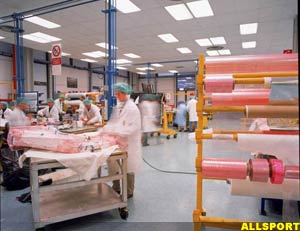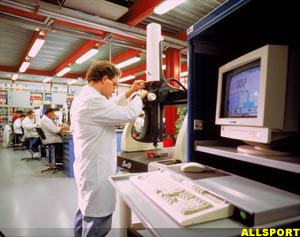|
Last year, Atlas F1 ran a series of articles that investigated the technical areas involved in design, development, and construction of an F1 car. Now, a year later, Will Gray picks up where he left off, and dives deeper into the technical analysis of Formula One.
Part A3: "Car Creators: On the shop floor"
 Once a part is designed it must be made, and that is where the rest of the boys down at the factory come in. Initial development in many areas is done on the wind tunnel model, and there is a specific section of the factory (the Model Shop) which is dedicated to manufacturing just these parts. This involves all of the manufacturing disciplines of the full size car, all done in the one department on a smaller scale, and leaves the rest of the factory to concentrate on the full size car. The main manufacturing areas for this are split into the Composite Shop (which works on carbon fibre parts), the Machine Shop and the Metal Shop (which work on the metal parts), and finally Sub-Assembly and the Race Shop (which brings it all together). Once a part is designed it must be made, and that is where the rest of the boys down at the factory come in. Initial development in many areas is done on the wind tunnel model, and there is a specific section of the factory (the Model Shop) which is dedicated to manufacturing just these parts. This involves all of the manufacturing disciplines of the full size car, all done in the one department on a smaller scale, and leaves the rest of the factory to concentrate on the full size car. The main manufacturing areas for this are split into the Composite Shop (which works on carbon fibre parts), the Machine Shop and the Metal Shop (which work on the metal parts), and finally Sub-Assembly and the Race Shop (which brings it all together).
The most important material in Formula One is carbon fibre. As much as its advantages are high strength and low weight, so too is its simplicity of manufacture. All bodywork is manufactured in carbon fibre by fabricators in the composite shop, which must be a clean environment to prevent contamination weakening the final part. Even the chassis is made here, constructed as upper and lower parts which are glued together using a special mixture of the resin used to make the original composite.
Although gluing a car together sounds a crazy idea, doing so will in fact create a bond that is as strong as the part itself. Unfortunately though, carbon fibre is not the kindest one in the world on the human being! When cutting or sanding a solid carbon fibre part, splinters can get into the skin and the carbon dust is far from a good thing to have in the lungs. To protect the fabricators from these problems, they will wear masks and gloves, and will also rub a special cream into their hands which prevents the skin irritation caused by the dust.
 Much as engineers wish it could, the entire car cannot be made of carbon fibre, and sometimes metal is the only thing suitable for the job. However, we're not talking heavy steel girders here - only the lightest materials will do, and most metals used on an F1 car tend to be super-strong alloys of aluminium or titanium. The manufacture of these parts takes place mostly in the Machine Shop, where lathes (which rotate a piece of metal at high speed and allow a fixed tool to cut material away) are used to create any circular section parts, and mills or CNC machines (which both use a rotating tool to cut material away from a fixed piece of metal) carve shapes out of solid metal. Much as engineers wish it could, the entire car cannot be made of carbon fibre, and sometimes metal is the only thing suitable for the job. However, we're not talking heavy steel girders here - only the lightest materials will do, and most metals used on an F1 car tend to be super-strong alloys of aluminium or titanium. The manufacture of these parts takes place mostly in the Machine Shop, where lathes (which rotate a piece of metal at high speed and allow a fixed tool to cut material away) are used to create any circular section parts, and mills or CNC machines (which both use a rotating tool to cut material away from a fixed piece of metal) carve shapes out of solid metal.
Now that 3D design is used and the drawing files can be sent directly to the computer, many of these machines are becoming computer controlled - but although the days of hand measurement and cutting by eye are long gone, machinists are still required to either operate the machines or at least check that they are doing what they are supposed to do. The metal shop is responsible for fabrication of all metal parts that cannot be made in the machine shop. Much of their work involves welding (attaching two pieces of metal together using a 'glue' of molten metal which then sets) or brazing (a similar technique) together pieces of metal. Although often not the most delicate processes, this can produce a highly accurate and strong product, and items such as the steering column are created in this way.
Rather than the permanent fixing of a weld, many parts are required to be removable and replaceable, so are designed to be bolted together using ready-made nuts and bolts. Although Formula One is fairly liberal when it comes to splashing out cash for manufacturing, even they don't make everything themselves, and often use standard off-the-shelf parts in their designs. These, along with any other material or parts going in or out of the factory, are the responsibility of the stores, who will ensure everything that is ordered ends up in the right place. Once a part has left the stores, or has been manufactured, it will go straight through to inspection. Here, using incredibly precise tools, a team will measure every part and compare it to its drawing, to ensure that it has been made correctly. If it hasn't, the part will be sent back, or the engineer responsible for the part will be called in to assess the situation. When it comes to the crunch, even millimetres can make the difference - a Formula One car is not designed to an accuracy of a hundredth of a millimetre just for fun!
 Finally, sub-assembly will take many of the intricate parts (the gearbox, for instance), and put them together ready to go onto the car. This allows these critical items, which often involve lots of moving components, to be assembled in a clean, contamination-free environment, and ensures the minimum chance of any race-stopping gremlins finding their way in. The mechanics, meanwhile, care to the car as a whole, and strip it down completely every time it comes home from the track. They will painstakingly clean it, replace old parts which are past their sell-by date, and fix any newly designed components onto it. Finally, sub-assembly will take many of the intricate parts (the gearbox, for instance), and put them together ready to go onto the car. This allows these critical items, which often involve lots of moving components, to be assembled in a clean, contamination-free environment, and ensures the minimum chance of any race-stopping gremlins finding their way in. The mechanics, meanwhile, care to the car as a whole, and strip it down completely every time it comes home from the track. They will painstakingly clean it, replace old parts which are past their sell-by date, and fix any newly designed components onto it.
The teams, then, involve a great number of personnel working in all areas of engineering, but the way to run a team differs in many team owners minds. Some (such as McLaren) like to manufacture everything in-house, just to make sure no-one goes blabbing to another team - whilst others (Jordan, for instance) prefer to feed out many of the manufacturing jobs to closely tied companies, keep a smaller facility, and concentrate more on design and car build. Whichever way you go, there will always be need for good people on the factory floor, as accuracy is essential to avoid failure and quite frankly, without them...well, there's no car!
|

